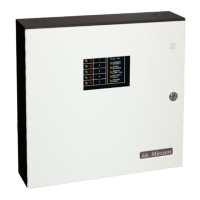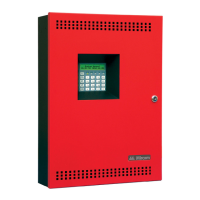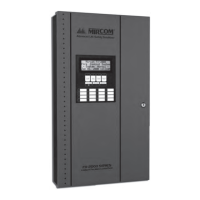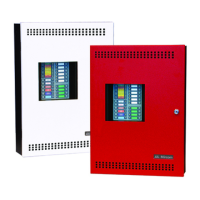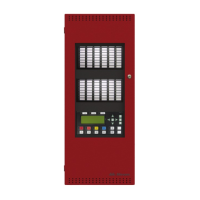51
Indicators, Controls, and Operation
8.1.9 General Alarm LED
The red General Alarm LED illuminates steadily after the General Alarm button is pressed, a
general alarm initiating circuit is activated, or the Auto General Alarm timer times out. Once
the General Alarm LED turns on, it will stay active until the panel is reset.
8.1.10 Configuration / Test Mode LED
The amber Configuration / Test Mode LED illuminates steadily to indicate that the panel is in
either walk test or configuration mode. If the panel is left in either mode for over an hour with
no operator activity, this LED will flash at the trouble flash rate.
8.1.11 Auxiliary Disconnect LED
The amber Auxiliary Disconnect LED flashes at the trouble flash rate after the Auxiliary
Disconnect button is pressed. It turns off after the button is pressed a second time. When on, it
indicates that common alarm and common supervisory relays are not activated, and
programmable relays (if disconnect is enabled) are not activated. The city tie module, if
installed, is also inactive.
8.1.12 Signal Silence LED
The amber Signal Silence LED flashes at the trouble flash rate when indication circuits are
silenced either by the Signal Silence button or by the Auto Signal Silence timer. It turns off
when the signals are re-sounded by a subsequent alarm.
8.1.13 Battery/Charger Trouble LED
The Battery/Charger Trouble LED flashes amber at the trouble flash rate when the battery is
either low (below 20.4 VDC) or disconnected.
8.1.14 Ground Fault LED
The Ground Fault LED flashes amber at the trouble flash rate when the Ground Fault Detector
detects a ground fault on any field wiring. It turns off when the ground fault is cleared.
8.1.15 CPU Fault LED
The CPU Fault LED Indicator illuminates steadily to indicate a microprocessor failure on the
main board.
Note: For Canadian installations, disable the Auto Signal Silence timer.
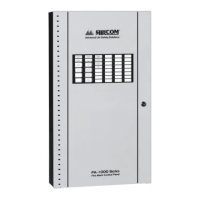
